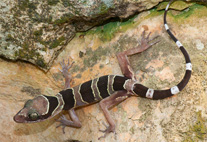Abstract
This work provides an inventory of species of free-living nematodes from Tunisian waters, based on samples collected from September 1977 until March 2013. Sediment samples were taken from 8 ecosystems: the Lagoons of Bizerte, Ghar El Melh and Bou Ghrara, Northern and Southern Lakes of Tunis, Old Harbor of Bizerte, Bizerte Bay and Ichkeul Lake. A total of 31 families, 133 genera, and 249 species of marine nematodes are currently known from Tunisia. The Xyalidae (with 30 species), Cyatholaimidae (25), Chromadoridae and Linhomoeidae (each 21) and Comesomatidae (20) are the richest families. Among them, Daptonema (with 9 species), Pomponema and Sabatieria (with 7 each) are the most species-rich genera. Some species were recovered only from a specific type of ecosystem. In detail, 109 species were recovered from lagoons, 56 species from sandy beaches and 6 species from mudflats. The 78 remaining species were widely distributed in Tunisian waters and four of these (Terschellingia longicaudata, Oncholaimus campylocercoides, Sabatieria pulchra and Theristus flevensis) were present in most of the 8 ecosystems studied.

